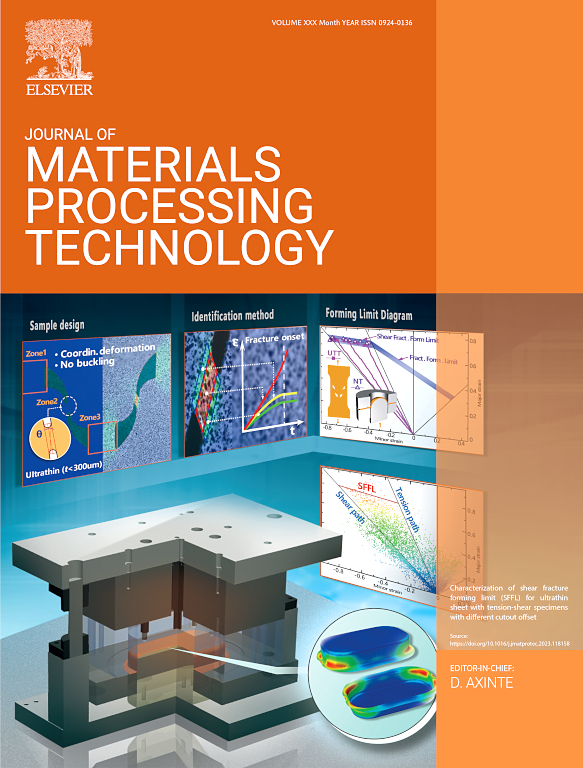Tuning the microstructures and mechanical properties of heterostructured steel fabricated via arc-based directed energy deposition and hot rolling
IF 7.5
2区 材料科学
Q1 ENGINEERING, INDUSTRIAL
Journal of Materials Processing Technology
Pub Date : 2025-07-11
DOI:10.1016/j.jmatprotec.2025.118985
引用次数: 0
Abstract
Heterostructured (HS) steels have attracted significant attention because of their excellent comprehensive mechanical properties. However, significant challenges remain, including controlling the distribution of heterogeneous regions, regulating microstructures, and developing efficient manufacturing processes. In this study, an HS steel composed of 18Ni300 maraging steel (MS) and 316 L stainless steel (SS) was fabricated via a combined arc-based directed energy deposition (DED-Arc) and hot rolling process. This approach enabled controlled distribution and adjustable thickness of heterogeneous regions. The HS steel was hot rolled from an initial thickness of 20 mm down to 2 mm and then aged at 500°C for different durations. It retained its heterogeneous structures throughout, demonstrating the feasibility of the proposed processing route. As the aging time increased, both the amount and size of nanoprecipitates within the MS tracks progressively increased. However, the strength of the HS steel initially increased and subsequently decreased, achieving an optimal balance between strength and ductility after aging for 6 h. The enhanced strength is attributed to precipitation strengthening and the heterodeformation-induced (HDI) hardening effects occurring at the heterogeneous interfaces. As the size of the nanoprecipitates increased, the deformation mechanism transitioned from shear mechanism to the Orowan mechanism, which inhibited strain within the martensitic regions near the interface. Strain partitioning at the interface facilitated increased dislocation generation on the austenitic side, leading to a maximum back stress of 954 MPa in the HR-A6 sample. This study contributes to the understanding of strengthening mechanisms in HS steels and proposes an efficient approach for fabricating high-performance HS materials.
电弧定向能沉积和热轧异质结构钢的组织和力学性能调整
异质结构钢因其优异的综合力学性能而受到人们的广泛关注。然而,重大的挑战仍然存在,包括控制异质区域的分布,调节微观结构,以及开发有效的制造工艺。采用电弧定向能沉积(ed - arc)和热轧相结合的工艺制备了由18Ni300马氏体时效钢(MS)和316 L不锈钢(SS)组成的HS钢。这种方法使非均质区分布可控,厚度可调。将HS钢的初始厚度从20 mm热轧至2 mm,然后在500℃下进行不同时间的时效处理。它始终保持其异质结构,证明了所提出的加工路线的可行性。随着时效时间的延长,质谱径内纳米沉淀物的数量和尺寸逐渐增大。时效6 h后,HS钢的强度先升高后降低,达到强度与延性的最佳平衡。强度的提高主要是由于析出强化和非均相界面处发生的异质变形诱导硬化效应。随着纳米沉淀尺寸的增大,其变形机制由剪切机制转变为Orowan机制,抑制了界面附近马氏体区域内的应变。界面处的应变分配促进了奥氏体侧位错的产生,导致HR-A6试样的最大背应力为954 MPa。该研究有助于理解HS钢的强化机制,并为制造高性能HS材料提供了有效的方法。
本文章由计算机程序翻译,如有差异,请以英文原文为准。
求助全文
约1分钟内获得全文
求助全文
来源期刊

Journal of Materials Processing Technology
工程技术-材料科学:综合
CiteScore
12.60
自引率
4.80%
发文量
403
审稿时长
29 days
期刊介绍:
The Journal of Materials Processing Technology covers the processing techniques used in manufacturing components from metals and other materials. The journal aims to publish full research papers of original, significant and rigorous work and so to contribute to increased production efficiency and improved component performance.
Areas of interest to the journal include:
• Casting, forming and machining
• Additive processing and joining technologies
• The evolution of material properties under the specific conditions met in manufacturing processes
• Surface engineering when it relates specifically to a manufacturing process
• Design and behavior of equipment and tools.
 求助内容:
求助内容: 应助结果提醒方式:
应助结果提醒方式:


